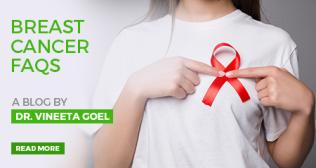
Combating Cervical Cancer: Unveiling Causes, Symptoms, and Prevention
Cervical cancer is the fourth most common type of cancer seen in women across the globe. While this may sound scary, it is also true that it can be treated easily when detected early. January is regarded as Cervical Cancer Awareness Month to spread awareness regarding this condition and focus on crucial work that needs to be carried out to eliminate this disease.
Understanding this condition — its causes, symptoms, preventive measures, and diagnostic tests — can help prevent the condition altogether or at least lead to an early diagnosis.
Cervical Cancer: Meaning and Prevalence
Cervical cancer originates in the cells of the cervix, the narrow lower end of the uterus that connects to the vagina.
It is the second most predominant type of cancer seen in Indian women and is responsible for up to 30% of cancers seen in seen.
Causes of Cervical Cancer
Most instances of cervical cancer are caused by human papillomavirus (HPV), which spreads through sexual contact. Long-lasting infections caused by certain types of HPV can lead to the development of abnormal cells, which turn cancerous in about 15 to 20 years. The risk factors for the progression of cervical cancer include the presence of sexually transmitted infections (STI) such as HIV, the grade of oncogenicity of the HPV type, early pregnancy, immune status, usage of hormonal contraceptives and smoking.
What are the stages of cervical cancer?
A cancer stage denotes the extent to which cancer has proliferated in the body.
According to The International Federation of Gynaecology and Obstetrics staging system, cervical cancer has four stages - I, II, III and IV. In stage I, the cancer is confined to the cervix. Across stages II and III, it spreads to the vagina before affecting the pelvic wall, kidney, and lymph nodes. Metastasis or the spread of cancer to other body parts is seen in stage IV. Knowing the stage of cervical cancer, one has is crucial to choose the right treatment.
What are the Symptoms of Cervical Cancer?
Often, there are no symptoms of cervical cancer in the early stages — these usually start showing after metastasis. When symptoms are seen in early-stage cervical cancer, they comprise the following:
- Vaginal bleeding after sex or after menopause
- Vaginal bleeding between menses.
- Pungent-smelling or bloody vaginal discharge that’s watery.
- Pain in the pelvic region or pain during intercourse
Apart from these, advanced cervical cancer could have the following signs:
- Difficult or painful bowel movements or bleeding from the rectum during a bowel movement
- Having trouble or pain while urinating
- Blood in the urine
- Dull back pain
- Leg swelling
- Abdominal pain
- Fatigue
While some symptoms may stem from other causes, it is best to visit your healthcare provider to rule out cervical cancer.
Screening and Diagnosis of Cervical Cancer
Screening for cervical cancer forms an essential part of routine healthcare for women. There are three major ways to screen for cervical cancer: the human papilloma virus (HPV) test, Pap smear test, and the HPV/Pap co-test.
Your healthcare provider can perform a physical exam, including a pelvic exam, to begin with. Besides, they might check on your medical history. Procedures such as colposcopy and biopsy are used to diagnose cervical cancer. Imaging tests such as a PET-CT scan and lab tests to study blood chemistry are conducted to determine the stage of cervical cancer, if the condition is diagnosed.
Prevention of Cervical Cancer
Taking dynamic steps, both in lifestyle choices and medical interventions, can crucially contribute to protecting your health and preventing cervical cancer.
- Fostering public awareness, access to information and services are gateways to prevention and control across the life course.
- Being vaccinated at age 9-14 years is a potent way to prevent HPV infection, cervical cancer, and other HPV-related cancers.
HPV Vaccination
Six HPV vaccinations with proven efficacy in preventing HPV infections and cervical cancer are currently available worldwide. These protect people against the high-risk HPV types 16 and 18, which are responsible for most cervical cancers.
HPV vaccines must ideally be administered to girls at the age of 9–14 years, before they become sexually active. However, if someone has not been vaccinated at this age, they can be vaccinated until the age of 45. Some countries have also chosen to vaccinate boys of at least nine years of age to decrease the burden of HPV in the community and avert cancers caused by HPV in men.



















